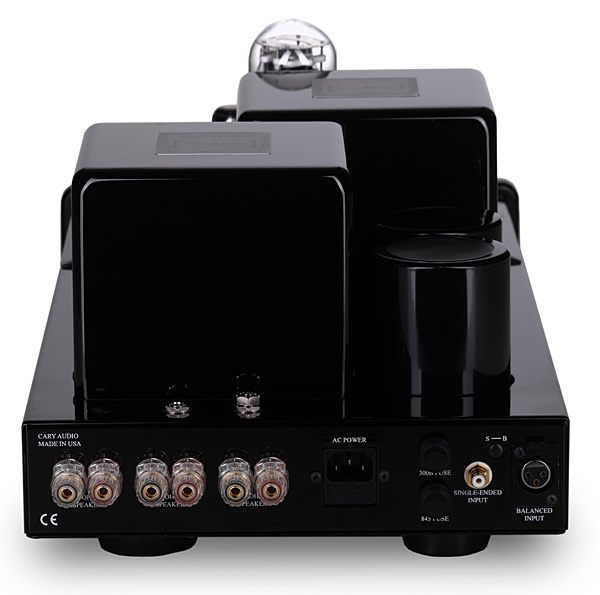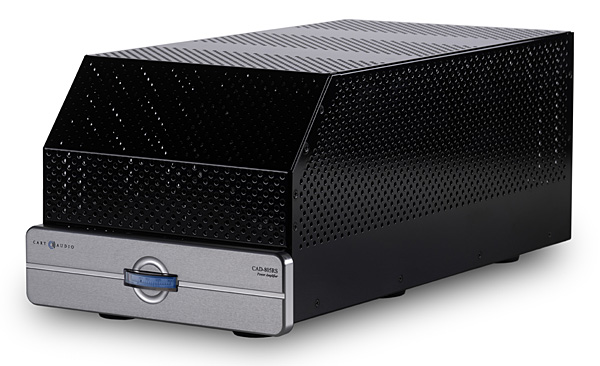| Columns Retired Columns & Blogs |
Love theme from the movie 'Romeo and Juliet' ............ Nino Rota :-) .........
Arthur Fiedler & Boston Pops Orchestra :-) .............
Henry Mancini :-) ............
Andre Rieu :-) .............

And so, throughout the 20th century, any number of trends in domestic audio popped up their heads, some remembered as fads, others as legitimate approaches to playback. Among the latter are amplifiers whose output sections operate in single-ended mode, in which the entire signal waveform is amplified by a single device (footnote 1)—usually a tube, most often a triode—rather than being split into positive and negative halves and sent to complementary pairs of output devices. Single-ended output stages, which by definition operate in class-A, were common in the early days of consumer electronics—most tubed table radios, for example, had single-ended outputs—and were phased out during the nascent solid-state era. But in the early 1990s that technology made a comeback in the high-end audio markets of Europe and the US, accompanied by a parallel interest in compatible high-efficiency speakers, particularly horns.
Until then, high-end audio had been strangely conservative, most of its distinctions existing on the plane of excess: more boxes, bigger boxes, costlier boxes, and ever more output power. Modern single-ended amps, which offer notoriously low output power—for example, the popular and altogether good 300B output triode, operated in single-ended mode, can just about manage 8W—were embraced by many, but derided by as many others. When I remember the condemnation of single-ended triode (SET) amps heard from some corners of our little world, I can't help thinking of Pete Seeger, he of the supposedly open mind, attempting to literally pull the plug on Bob Dylan's electric band at the Newport Folk Festival of 1965.
With a wink—and, one assumes, more than a little cunning in the un-small matter of newsstand sales—the cover of the January 1994 issue of Stereophile gained attention by juxtaposing a 300Wpc, push-pull, solid-state Krell KSA-300S amplifier and a 27W, single-ended, tubed Cary CAD-805 amplifier, and declaring: "If either of these amplifiers is RIGHT . . . the other must be WRONG." The controversy was real; the dichotomy wasn't. Both were, and are, good amps, suited to different systems and different priorities in playback characteristics—in other words, suited to different humans, which the most serious hobbyists sometimes forget they are.
In 2019, it's still easier to find something like the Krell than the Cary. Yet Cary Audio continues to thrive, and 25 years later that very same amp endures, having evolved into the CAD-805RS monoblock ($15,995/pair), the last two letters of its name standing for Reference Series.
Description
Now as then, Cary's top model of single-ended monoblock is nearly twice as deep as it is wide: a shotgun house of an amp whose 24" by 12.25" steel case rules out most equipment racks of my experience, my own included. Immediately behind its aluminum front plate—available in silver or black, the latter to match the rest of the case—are two 6SN7 dual-triode input tubes, plus a brace of user controls including toggle switches for separately powering up the tube filaments (On/Off) and tube plates (Operate/Standby). Lined up behind these are: one 300B directly heated driver tube; one 845 or 211 directly heated triode output tube (both are supplied); output and mains transformers, and power-supply reservoir capacitors; and a potentiometer for adjusting the driver tube's bias current. On the rear panel are RCA and XLR inputs, both unbalanced, and a small toggle switch for selecting between them, alongside three pairs of output jacks, for loudspeaker loads of 4, 8, and 16 ohms.

The CAD-805RS mixes fixed-bias and auto-bias circuitry. The gain stage formed by the two 6SN7 tubes is capacitively coupled to the grid of the 300B, which operates in fixed-bias mode; bias for that tube is adjusted with the aforementioned pot, the user relying on either the ammeter built into the Cary's front panel or an external ammeter (footnote 2) with a range of at least 0–300mA, which can be plugged into a ½" phone jack next to the bias pot. The plate of the 300B is transformer-coupled to the control grid of the user's choice of an 845 or 211 triode. That output tube is operated in auto-bias: Its control grid is referenced to ground, and its cathode is held above ground by means of a stout resistor—and so, without the need for a bias-supply stage, which adds complexity and expense, the grid has the desired negative charge relative to the cathode.
Or, at least, it does most of the time. Cary uses a neat trick to extend the CAD-805RS's output beyond that of which a single-ended 845 or 211 is normally capable: Under demanding playback conditions, when the amp is compelled to pass ever-greater amounts of current across the loudspeaker load, the Cary's output section slides into class-A2, in which the control grid goes from being negatively to positively charged—again, relative to the cathode. Thus the control grid goes from selectively impeding current between the cathode and the positively charged plate to scooting along that flow of electrons—while continuing to mimic the shape of the AC music signal that's also on the grid. But class-A2 output is prone to distortion, so the CAD-805RS is designed to remain in pure class-A for all but the briefest of moments.
According to Cary's specifications, when run with an 845 output tube, the CAD-805RS can produce 27W in class-A and up to 50W in class-A2; with the 211 output tube, those numbers are, respectively, 27 and 70W. Among the amp's other user controls is a two-position knob that must be set to the correct position for the tube in use; presumably this sets the voltage potential available at the cathode pin. The remaining user control—another knob, this one with continuous travel—lets the user adjust the amount of negative feedback applied, from 0 to 10dB. This can be done while the amp is in use.

The CAD-805RS is well built and, despite its generous and somewhat unusual proportions, very nice looking. (Supplied with each amp is an aluminum tube cage, also black, though Cary didn't include those with my review samples.) The basic chassis and bottom plate are steel, the upper deck aluminum; the amp sits on six soft, Sorbothane-like feet fastened to its bottom. Inside, all wiring is point-to-point, with nary a circuit board in sight. The mains and output transformers are designed by Cary and made in the US by a firm that, according to Wright, has supplied Cary with transformers for over 25 years. DC rail voltage is provided by a full-wave rectifier comprising 16 of the most robust discrete diodes I've ever seen, while low-voltage AC for the tube filaments is supplied by a small Triad transformer that's separate from the main mains transformer. Signal and bypass caps are a mix of Solens and, mostly, Mundorfs.
Installation and setup
Each of the two Cary CAD-805RS monoblocks arrived in an unusually sturdy cardboard carton inside its own wooden crate, the amp secured within the carton with various foam fittings, and each tube in its own little box. Plain black power cords are provided, as well as simple cotton gloves for handling the tubes without leaving behind skin oils or other contaminants. (I don't always take such precautions when handling tubes, but I did with these—especially the 845s and 211s.)
In their very good owner's manual, Cary says that where the CAD-805RSes are placed is not critical; I took them at their word and put the amps on the floor, next to my Box Furniture rack. The manual also suggests that the bias current for each amp's 300B driver tube has been set at the factory, but advises that the user check that amp's meter after 15 minutes of warmup and to adjust, if needed. Only once did I find that necessary: when I corrected a small dip in the bias current of the CAD-805RS assigned to my system's left channel (serial no. 180218).

Although I can't put a number to it—that will have to await John Atkinson's measurements—it was apparent from the start that the Carys produced a great deal of gain: Used with my Shindo Laboratory Monbrison preamp, itself a voltage-gain champ, the Carys were almost too much for my system, forcing me to keep the Shindo's volume setting near the bottom of its range. (Like all Shindo power amps, my Haut-Brion has individual left- and right-channel level controls, thus preventing such difficulties and also serving as a balance control.) Since most stereo volume pots exhibit poor channel tracking at the extreme low end of their range, I disregarded apparent anomalies in image location; that said, if there was a difference in gain between the two Carys, it might have gone unnoticed.
Footnote 2: Cary offers an optional meter for $100. However, CEO Billy Wright told me via e-mail that the meter built into the CAD-805RS's front panel "is very accurate."

Love theme from the movie 'Romeo and Juliet' ............ Nino Rota :-) .........
Arthur Fiedler & Boston Pops Orchestra :-) .............
Henry Mancini :-) ............
Andre Rieu :-) .............

"I Was Made for Lovin' You" baby ......... Kiss :-) ............

These are old Dennis Had designs. They were great amps and a bit noisy. Surprised that small improvements weren't made in the years since Had left assuming the company intended to go back to their roots. The AES Six Pacs had to be the best value monoblocks to have ever been produced. I still have a pair in a closet somewhere with an SLP98 pre.

May be AD or JA could review the Carver Crimson/Raven 350 tube mono-bloc amps ($10,000) for comparison? ...... They are rated 350 WPC :-) ...........

This amp looks good without the protective net, but boring with the net on. The price (you can get a decent used car for this much money) and the measured THD are astronomical. In sum, a perfect toy for audiophiles swimming in money.